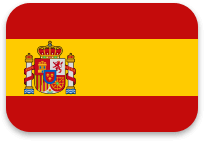Did you know that the Spanish-speaking world has almost 600 million people? That includes both natives and learners who have acquired the language. If you plan to sip coffee in a Madrid café or take your dancing skills to the next level in a salsa club in Cuba, starting with the alphabet is essential. The Spanish alphabet is the foundation for mastering the language itself. It’s necessary when spelling your name.
📙 You may also like our article on Spain Spanish vs Mexican Spanish.
How Many Letters Are There in the Spanish Alphabet?
The Spanish alphabet has 27 letters. Compared to the English ABC, which only counts 26 letters, Spanish speakers have an extra letter: "ñ."
You may wonder why we even have this question. The number of letters in the Spanish alphabet has changed over the years due to linguistic changes and the addition and removal of certain letters. In 2019, there were 29 letters in the Spanish alphabet. The current number of letters was officially confirmed in 2010 by the Real Academia Española (RAE) to standardize the language after removing "ch" and "ll" ("doble ele").
Here’s the complete list of Spanish letters:
A, B, C, D, E, F, G, H, I, J, K, L, M, N, Ñ, O, P, Q, R, S, T, U, V, W, X, Y, Z
The Spanish Alphabet - Pronunciation
El Abecedario is rather straightforward for English speakers. Most letters are the same, except for the Spanish "ñ," the only special character in the alphabet.
| Letter | Name | Pronunciation | Example | Translation |
|---|---|---|---|---|
| A | ah | like "a" in "father" | Amigo | friend |
| B | be | like "b" in "boy", softer between vowels | Burro | donkey |
| C | se | "s" before "e" or "i", "k" otherwise | Casa | house |
| D | de | Softer between vowels | Día | day |
| E | eh | like "e" as in "get" | Estrella | star |
| F | efe | like "f" in "family" | Fuego | fire |
| G | he | like "h" before "e" or "i" like hard "g" otherwise | Gato | cat |
| H | hache | silent in most cases | Hola | hello |
| I | ee | like "ee" in "see" | Iglesia | church |
| J | jota | like "h" in "house" | Jardín | garden |
| K | ka | like "k" in "kite" | Kilogramo | kilogram |
| L | ele | like "l" in "love" | Libro | book |
| M | eme | like "m" in "man" | Mesa | table |
| N | ene | like "n" in "no" | Nube | cloud |
| Ñ | eñe | like "n" in "canyon" | Niño | Boy, child |
| O | oh | like "o" in "more" | Ojo | eye |
| P | pe | like "p" in "pet" | Perro | dog |
| Q | ku | like "k" in "kite" | Queso | cheese |
| R | ere | like "r" in "butter" (soft) or like "roll" (hard) | Río | river |
| S | ese | like "s" in "snake" | Sol | sun |
| T | te | like "t" in "top" | Tigre | tiger |
| U | oo | like "oo" in "moon" | Uva | grape |
| V | ve | like "b" in "boy" or "v" in "vase" | Viento | Wind |
| W | doble ve | like "w" in "water" | Wifi | wi-fi |
| X | equis | like "x" in "box" | Xilófono | xylophone |
| Y | ye | like "y" in "yes" | Yate | yacht |
| Z | zeta | like "s" in "see" (in South America) or like"th" in "think" (in Spain) | Zapato | shoe |
Special Characters in Spanish
Aside from the 27 letters presented above, there are six more variations of letters with accents. Why aren't these included in the alphabet? That's a great question. None of them, except for "Ñ," is considered a separate letter. They are seen as variants of the existing letters, modified by an accent ("acento"), tilde (~), or umlaut ("diéresis").
Why do we need accents in Spanish? That's another great question! They indicate where the stress falls in a word. But besides their role in proper pronunciation, they also indicate different word meanings. For example, "sí" means "yes," while "si" means "if." "Cómo" translates as "how," and "como" means "as" or "like."
| Letter | Name | Pronunciation | Example | Translation |
|---|---|---|---|---|
| Á | A con acento | "a" as in "cat" | Árbol | tree |
| É | E con acento | "E" as in "bet" | Éxito | success |
| Í | I con acento | "I" as in "machine" | Fácil | easy |
| Ó | O con acento | "O" as in "more" | Corazón | heart |
| Ú | U con acento | "U" as in "food" | Útil | useful |
| Ü | U con diéresis | "U" with a slight "w" sound | Bilingüe | bilingual |
Interesting Facts about the Spanish Alphabet

The Spanish alphabet may surprise learners with a few fun particularities that are just as colorful as the culture. The most important thing to remember is that Spanish is a phonetic language, which is a great advantage. That means words are typically read the way they are spelled. So, unlike English, where you must constantly learn to pronounce new words, Spanish words are easy to read based on just a few reading rules.
All the Letters Are Feminine
As a concept, all spanish letters in the ABC are considered feminine. This is a unique perk not found in other alphabets. So, don’t forget to use a feminine article when referring to a Spanish letter.
"Ch" and "Ll" Used to Be in the Alphabet
Historically, "ch" and "ll" were once considered distinct letters in the Spanish alphabet. They were introduced for clarity, and even dictionaries listed words in separate sections from "c" and "l" under "ch" and "ll." By removing the two-letter combinations, Spanish wanted to standardize its alphabet and make it more accessible for learners worldwide.
You may also notice "rr" ("doble erre") as a separate letter in older dictionaries. That is no longer the case in the modern Spanish alphabet.
K and W Are Rare Letters
You will notice a few words that include "K" or "W." Most of them are borrowed from other languages, such as "wok" from Chinese, "kárate" from Japanese, "watt" from English, etc.
Popular Vowels
There are 5 vowels in Spanish: a, e, i, o, and u. "E" is the most popular, followed by "a" and "o." Spanish vowels are pronounced the same regardless of their position within a word, a significant difference that English speakers find convenient.
B and V Are Pronounced the Same
The letters "b" and "v" are pronounced the same in Spanish. The sound is in between "b" and "v," leaning more toward "b." To distinguish them as separate letters, "b" is called "be larga" ("long b"), and "v" is known as "ve corta" ("short v") in some regions. That's good to know when Spanish native speakers spell names or words for you.
Common Pronunciation Mistakes in Spanish

Since English and Spanish have different phonetic systems, English speakers may encounter pronunciation difficulties in Spanish. It takes time and practice to get used to the idea that a specific sound is attached to a letter. Below are some of the most common pronunciation mistakes Spanish learners make.
Confusing "ll" and "y"
The Spanish "ll" sound does not exist in English, so it's often confused with the "y" sound. However, there is a subtle difference in correctly articulating it. The "ll" sound is pronounced like the English "y" in "yes." To produce the Spanish sound, you need to press your tongue against the hard palate so that the air flows along the sides of the tongue.
Mispronouncing "j"
The Spanish "j" sound is pronounced like the English "h" sound in "hat," but with a more guttural sound. One mistake English speakers often make is pronouncing "j" too softly.
Mispronouncing "r"
The Spanish "r" sound is pronounced differently from the English "r" sound. It is a trilled sound made by vibrating the tongue against the roof of the mouth. English speakers often struggle because the English "r" (as in "red") is softer and lacks this vibration. Under-trilling is important to correctly pronounce words like "caro" ("expensive") and "carro" ("car"). While some dialects use alternative pronunciations, mastering the trill ensures clarity.
Mispronouncing "ñ"
The Spanish "ñ" sound does not exist in English, which is why English speakers often mispronounce it. The correct way to articulate it is by pressing the tongue against the hard palate while the air escapes through the nose. The result is somewhat similar to the English "ny" sound in "canyon." To practice this sound, it's useful to repeat words such as "niño" ("child") or "mañana" ("tomorrow") while keeping the tongue flat against the roof of the mouth.
Mispronouncing "h"
The trouble with the "h" sound in Spanish is that it is silent in most cases ("hola," "hablar") but often pronounced in loanwords ("hámster," "hashtag," "hipster"). English speakers tend to pronounce it all the time, which creates confusion. A helpful rule to remember is that newer, more modern words are loans from English, and the "h" is pronounced. In all other cases, don't pronounce it.
Pronunciation Training Tips

Learning to speak Spanish isn’t just about mimicking sounds. It's key to train your ear and embrace the rhythm of the language. And the most effective way to do that is through regular practice. Set a routine in which you regularly listen to natives speak and repeat after them to achieve near-native fluency.
Immerse Yourself in Spanish
Watch Spanish movies and TV shows, and listen to music and podcasts to get a feel for the rhythm and intonation of the language. Pay attention to how native speakers pronounce words and try to mimic their pronunciation. Even if you have Spanish songs and podcasts playing in the background while you're doing house chores or driving, you benefit from exposure to the target language.
Record Yourself
Record and listen to your pronunciation using your phone or any other device. Repeat after a news reporter or any native speaker who articulates words well. Listen to your recording to identify areas for improvement and check your progress. This is an effective way to pinpoint specific sounds or words that need more practice.
Pay Attention to Regional Variations
Be aware that Spanish pronunciation can vary by region. For example, the pronunciation of "c" and "z" in Spain differs from that in Latin America. Familiarize yourself with these regional variations to choose the right audio materials to focus on and to better understand and communicate with native speakers from different areas.
Practice with Tongue Twisters
Tongue twisters can help you learn Spanish. They improve your pronunciation and build fluency. They force you to focus on the correct pronunciation of specific sounds. Examples include "Tres tristes tigres tragaban trigo en un trigal" to train the combination "tr,"and "El perro de San Roque no tiene rabo porque Ramón Ramírez se lo ha robado" to polish up the challengin "r" sound.
Learn the Spanish ABC with FunEasyLearn

The ABC section includes the Alphabet itself and the set of reading rules. The rules are essential for pronunciation, spelling, and reading.
FunEasyLearn makes learning the Spanish ABC easy. Although the 63 rules may seem daunting at first, the fun games make practicing extremely enjoyable.
Educational games to learn the Spanish letters:
- Learn the letter
- Write the letter (you can skip writing games for languages like Spanish, but they are indispensable for other alphabets, for instance, Japanese)
- Listen & choose the sound
- Vowel or Consonant
- Fill in the blank
Interactive games to learn the reading rules in Spanish:
- Examples
- Listen & Write
- Listen & Complete
- Write word
- Choose word
- Listen & find
Go beyond the alphabet and learn high-frequency Spanish words and sentences. Build a strong vocabulary of 6,000 words and 5,000 phrases, sentences, and expressions. Enjoy learning anytime and anywhere in offline mode and make the most of every minute with an ad-free experience.
Summing Up
The Spanish alphabet has 27 letters, including the unique "ñ." Over time, there were several changes, such as adding and removing "ch" and "ll" as separate letters. Spanish has a phonetic pronunciation, making it easy to learn new words. Accents in Spanish letters indicate the word stress and can change the meaning of words, while "b" and "v" are pronounced the same, distinguished in some areas as "be larga" and "ve corta." Learning Spanish with FunEasyLearn is entertaining and efficient due to the numerous educational games.
Are you ready to learn the Spanish ABC?











